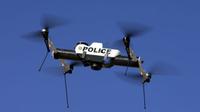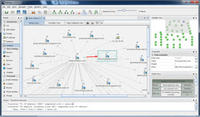-
Kansas history says DHS opened his mail -- again
Grant Goodman, a retired professor at the University of Kansas, was shocked when he found out that DHS opened his mail in 2005, but now that it has happened again, he just wants to know why; CBP does not need a warrant or probable cause to check international mail or cargo
-
-
License plate scanners in Canada under fire from privacy commissioners
British Columbia’s privacy commissioner is not happy about the way police departments are using their license-plate scanners; in a report released last week, Commissioner Elizabeth Denham said changes must be made to the Victoria police department’s Automated License Plate Recognition Program (ALPR), after it was discovered that the program could be used as a surveillance tool
-
-
DARPA seeking surveillance technology to predict future behavior
DARPA has teamed up with scientists from Carnegie Mellon University to create an artificial intelligence system that can watch and predict what a person will “likely” do in the future, using specially programmed software designed to analyze various real-time video surveillance feeds; the system can automatically identify and notify officials if it recognized that an action is not permitted, detecting what is described as anomalous behaviors
-
-
Searching social media sources by geography
Geofeedia, has created a group of algorithms that can search multiple social media sources by geography in real time; the postings, pictures, and tweets that show up in the results of a search are geolocation-enabled, are free, and results can be streamed on a mobile device, computer, or tablet. Businesses may have to pay a fee for more intensive searches
-
-
Jill Kelly’s FBI friend helped launch the investigation, then tipped lawmakers
Jill Kelly, a Petraeus family friend, was warned in a series of anonymous e-mails not to get too close to CIA director David Petraeus; Kelly contacted a friend who worked in the FBI Tampa office, and he persuaded the agency cyber squad to investigate; in late October, fearing that FBI director Robert Muller would sweep the investigation’s results under the rug, he contacted Rep. David Reichert (R-Washington), who, in turn, alerted the majority whip, Rep. Eric Cantor (R-Virginia); the Tampa agent is now under investigation by the Office of Professional Responsibility, the internal-affairs arm of the FBI
-
-
U.S.-Iran tensions rise as Iran tries to disrupt U.S. reconnaissance flights in Gulf
Tensions between the United States and Iran increase as news emerged last week of an attempt by four Iranian fighter planes, on 1 November, to shoot down a U.S. Predator drone engaged in a surveillance mission over international water in the Persian Gulf
-
-
CIA-commissioned climate change report outlines perils for U.S. national security
U.S. national security leaders believe that the accelerating pace of climate change will place severe strains on U.S. military and intelligence agencies in coming years; the reason, according the National Research Council, the U.S. top scientific research body: climate changes will trigger increasingly disruptive developments around the world; a 206-page National Research Council study, commissioned by the CIA and other U.S. intelligence services, concludes that states will fail, large populations subjected to famine, flood, or disease will migrate across international borders, and national and international agencies will not have the capacity or resources to cope with the resulting conflicts and crises
-
-
New cell phone surveillance method raises privacy concerns
The FBI is using a new method to access cell phone customer data,butthe American Civil Liberties Union (ACLU) contends that the method is overly invasive
-
-
Smart camera to describe what it sees -- and reason about what it cannot see
Army scouts are commonly tasked with covertly entering uncontrolled areas, setting up a temporary observation post, and then performing persistent surveillance for twenty-four hours or longer; what if instead of sending scouts on high-risk missions the military could deploy taskable smart cameras? A truly “smart” camera would be able to describe with words everything it sees and reason about what it cannot see
-
-
DHS finally investigates Border Patrol policies on deadly force

It was reported last week that DHS’s Office of the Inspector General was investigating charges of excessive force by Border Patrol guards at the Mexican border; to change the dysfunctional culture prevalent among some Border Patrol agents in certain border stations, however, will require much more than an investigation by DHS IG of policies regarding the use of deadly force; what is required at a bare minimum is more, not less, professional training at the national academy, a legitimate mentorship program for all new agents by experienced mentors, legitimate agency support for continued professional development of agents, promotions based on merit rather than paternalistic decision-making, and a number of other reforms neither DHS nor the CBP are willing to acknowledge
-
-
As domestic use of drones grows, privacy advocates worry

Small aerial drones are moving from the battlefield to local communities, and the pace grows faster; during the next year, drones may be used in cities and towns to help fight crime and keep officers out of danger; their use would save on the cost of fuel for police helicopters; some would feel safer as a result, but activists worry that this could be the beginning of a systemic invasion of privacy
-
-
Border Patrol relies in obsolescent surveillance gear
An Obama administration plan to update equipment the Border Patrol is using did not materialize, and now officials are concerned about outdated equipment putting the lives of agents in danger; the sensors now in use were originally said to be able to put Border Patrol agents in position to capture 90 percent of border invaders, but the DHS inspector general determined that just 4 percent of the alarms were confirmed cases of smugglers and border crossers; 34 percent were false alarms, and 62 percent were undetermined
-
-
Hezbollah drone represents changing technological landscape for Israel
Israel’s air defenses worked just fine in handling the drone launched by Hezbollah last week: the drone was picked up by Israeli surveillance as it was launched from southern Lebanon, then tracked as it flew south over the Mediterranean; it was allowed to enter Israeli air space so that after it was shot down, its remains could be collected and analyzed; still, the incident made many Israelis sit up and take notice; Israel, a country which has pioneered the use of UAVs as an integral part of military operations and which has held a monopoly on operating drones in the region, was forced to realize that is adversaries, too, now had access to the technology
-
-
Worries about UAV use in both military and domestic missions exaggerated

Dr. Steven P. Bucci, a Senior Fellow for Homeland Security & Defense Issues at the Heritage Foundation, talked with Derek Major, the Homeland Security News Wire’s executive editor, about the growing use of UAVs in both military and domestic law-enforcement missions; Bucci says that in targeting militants, American drone operators exercise a great deal of care to minimize, and eliminate if possible, death and injury to innocent civilians; he also says that the use of drones in domestic law-enforcement missions, if done properly, will not pose Big Brother risks, because drones may make surveillance easier and cheaper, but it will not give law-enforcement agencies any new authorities
-
-
New app uses scattered public information to put together a digital footprint of individuals, organizations

A new app application can collect scattered online clues to provide a picture of individuals or organizations; the application draws on public data sources in order to put together a graphical digital footprint
-
- All
- Regional
- Water
- Biometrics
- Borders/Immig
- Business
- Cybersecurity
- Detection
- Disasters
- Government
- Infrastructure
- International
- Public health
- Public Safety
- Communication interoperabillity
- Emergency services
- Emergency medical services
- Fire
- First response
- IEDs
- Law Enforcement
- Law Enforcement Technology
- Military technology
- Nonlethal weapons
- Nuclear weapons
- Personal protection equipment
- Police
- Notification /alert systems
- Situational awareness
- Weapons systems
- Sci-Tech
- Sector Reports
- Surveillance
- Transportation
Advertising & Marketing: advertise@newswirepubs.com
Editorial: editor@newswirepubs.com
General: info@newswirepubs.com
2010-2011 © News Wire Publications, LLC News Wire Publications, LLC
220 Old Country Road | Suite 200 | Mineola | New York | 11501
Permissions and Policies
Editorial: editor@newswirepubs.com
General: info@newswirepubs.com
2010-2011 © News Wire Publications, LLC News Wire Publications, LLC
220 Old Country Road | Suite 200 | Mineola | New York | 11501
Permissions and Policies
